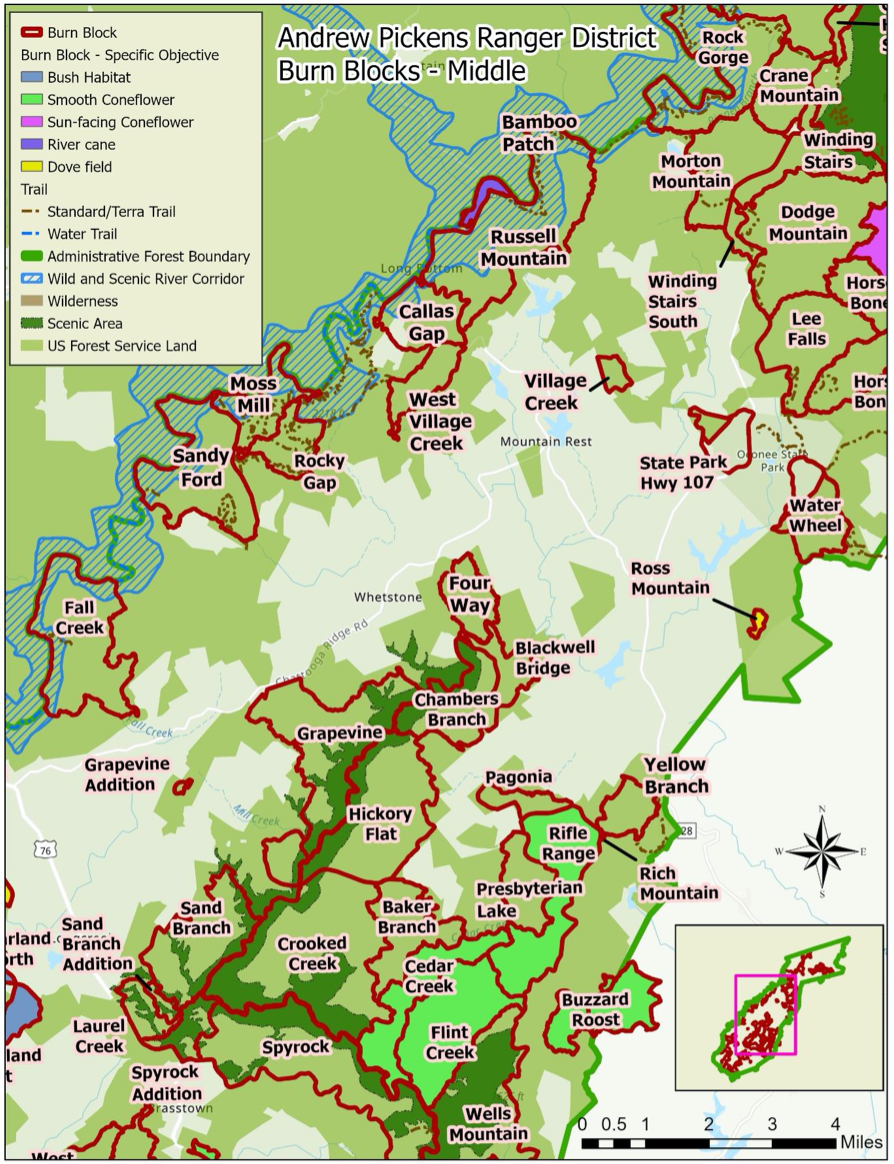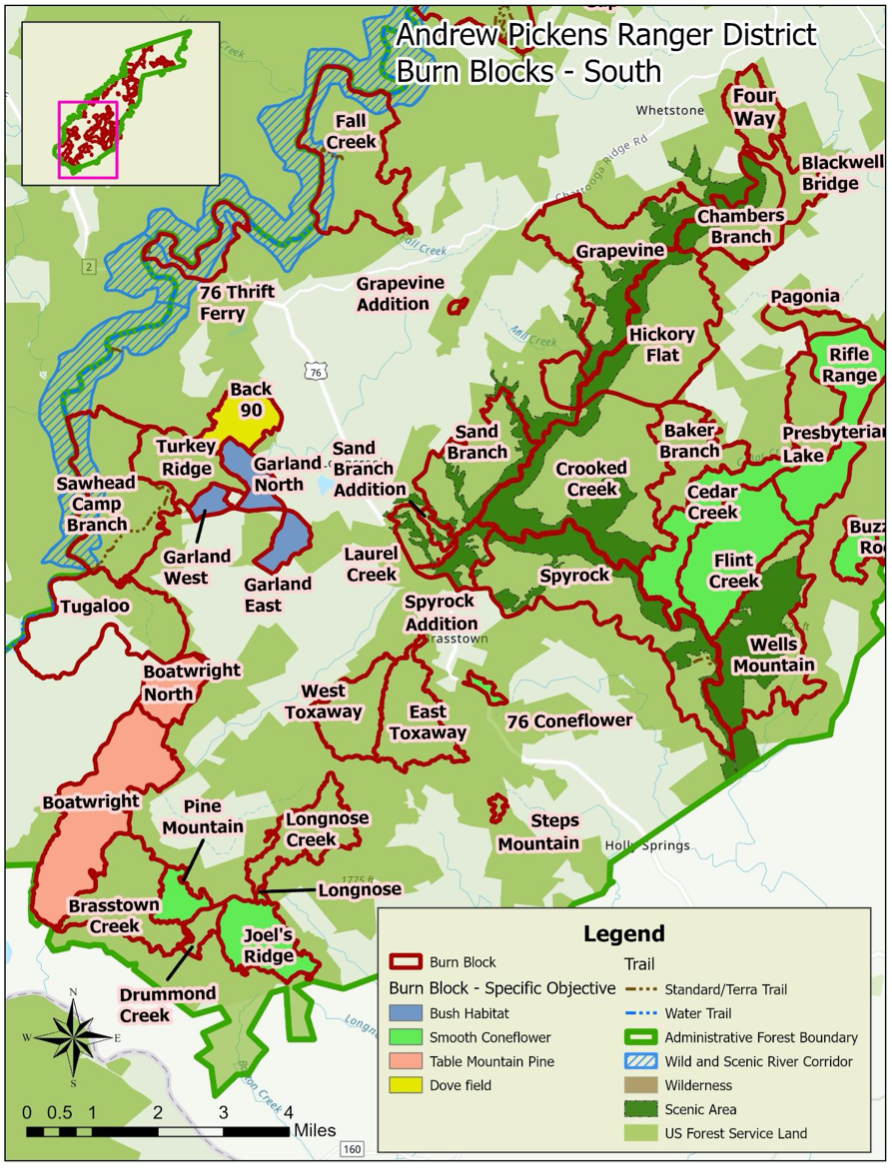FIRE
Prescribed fire–planned fire intentionally set to meet land management objectives–is utilized across the Chattooga River watershed and surrounding national forests each year. We review and respond to burn plans from USFS Districts and monitor for impacts on communities and ecosystems.
The USFS maintains the “Southern Region Prescribed Burn Accomplishment Tracker,” an interactive map displaying planned and completed burns:
South Carolina
Sumter National forest
In 2024, the Andrew Pickens Ranger District approved a multi-year plan to implement prescribed burning on over 41,000 acres of Sumter National Forest lands–about half the district’s entire acreage–including over 3,200 acres in the Chattooga River Wild & Scenic corridor. Read our comments here.
The Andrew Pickens Ranger District (APD) Prescribed Fire plan involves burning 4,000 to 9,000 acres per year, with fire-return cycles of every 2-8 years for this annual acreage, including some burning during the growing season (prescribed burns normally are done during the dormant season). This is much more frequent and of a larger scale than what has historically occurred in the Chattooga watershed! We believe prescribed burning to this degree is not geared toward ecological restoration and maintenance, but is instead designed to cultivate a few desired “crop tree” species of pine and oak to feed commercial timber markets – a practice that would homogenize our biologically diverse native forests. The plan Environmental Assessment (EA) further admits there is “potential for significant environmental effects” on soil resources from unintentional “hot” fires, and acknowledges activities that could “adversely affect aquatic habitats through increased sedimentation in creeks and streams.”
Much of the Chattooga watershed’s temperate rainforest ecosystem has evolved and developed under extremely wet conditions. Many sensitive native plants and animals are adapted to these unique natural regimes. Species such as the threatened Green Salamander, and other Plethodon (lungless, woodland) salamander species; understory songbirds as well as ground-nesting game species, such as wild turkey; the endangered Northern Long-eared Bat; and many sensitive understory plants, such as native flame azaleas, mountain camellia, and fringe tree, would all be put at risk. These burning areas would also become more susceptible to invasive species; as the EA states, fire-line creation (362 miles as per EA), alone, would “likely introduce and spread new infestations of non-native invasive plant species.”
This burning plan includes using both the Chattooga National Wild & Scenic River corridor and the eligible Chauga Wild & Scenic River corridor as fire lines, and the project will reportedly impact 58 miles of 30 authorized trails. Poor air quality from fire events will negatively impact recreation opportunities in the APD, and will spread to surrounding communities.
The case for low-intensity prescribed burning may be justified in parts of the APD; however, it is simply not warranted or justified at the level the APD is now enacting, which is out of sync with natural fire regimes of the watershed. The Chattooga Conservancy submitted comments throughout the project planning process. View our full comments on the Draft EA and Finding of No Significant Impact (FONSI) here: Andrew Pickens RD Prescribed Fire Draft EA & FONSI – Chattooga Conservancy comments.
The above maps and full USFS plan documents are available here: Andrew Pickens Prescribed Fire Page
Georgia
Chattahoochee-Oconee National forest
The Chattooga Ranger District periodically conducts prescribed burns in and near Rabun County. You can sign up to receive email alerts about upcoming prescribed burns in the Chattahoochee-Oconee National Forest here:
CONF #BurnAlerts.
IMPACTS
Prescribed burn plans are now underway around the watershed in early 2025, and many in the community have already been impacted by smoke while working, recreating, or otherwise engaging in outdoor activities. The AP District shares fire alerts on Facebook, radio, and via text message (call 864-638-9568 to join the One Call Now list), while the CONF sends emails (#BurnAlerts) and posts on Facebook. We are urging the AP District to develop an email notification system similar to that of the CONF to help citizens and visitors–especially those with increased health risks–plan ahead on days when normal outdoor activities may be affected by reduced air quality. The more voices the better! If you’d like to share your experience related to these prescribed burns, please contact us using the form below.






